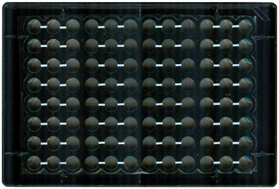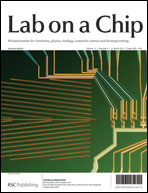A continuous perfusion microplate for cell culture†
Abstract
We describe a 96-well microplate with fluidically connected wells that enables the continuous fluid perfusion between wells without the need for external pumping. A single unit in such a perfusion microplate consists of three wells: a source well, a sample (cell culture) well in the middle and a waste well. Fluid perfusion is achieved using a combination of the hydrostatic pressure generated by different liquid levels in the wells and the fluid wicking through narrow strips of a cellulose membrane connecting the wells. There is an excellent correspondence between the observed perfusion flow dynamics and the flow simulations based on Darcy's Law. Hepatocytes (C3A cells) cultured for 4 days in the perfusion microplate with no media exchange in the cell culture well had the same viability as hepatocytes exposed to a daily exchange of media. EOC 20 cells that require media conditioned by LADMAC cells were shown to be equally viable in the adjacent cell culture well of the perfusion microplate with LADMAC cells cultured in the source well.


 Please wait while we load your content...
Please wait while we load your content...